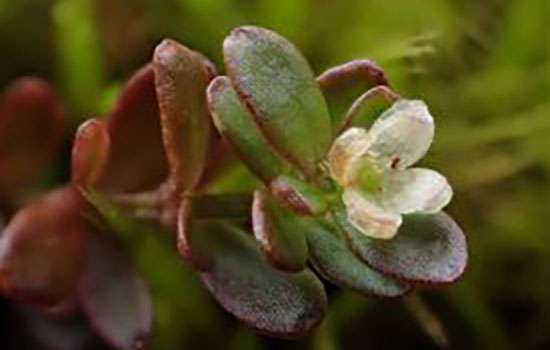Monash discovery triples critically endangered plant population

A new population of a critically endangered plant species has been discovered on sub-Antarctic Macquarie Island, tripling the previously known population to some 1500 plants.
The tiny, herbaceous Galium antarcticum ('sub-Antarctic bedstraw'), was recently discovered by chance at Skua Lake, near the central west coast of the Island, by Monash University PhD student Cath Dickson.
"I was on my hands and knees examining other plants around the lake when I spied Galium antarcticum," she said.
"I couldn't believe it...I wondered if I was seeing things."
Her disbelief is understandable as Galium antarcticum is tiny, generally less than 50 mm long, and grows in association with moss beds, making it easy to overlook.
Ms Dickson and fellow botanist, Dr Alex Fergus from the Department of Conservation New Zealand, surveyed the area and found 1000 healthy individuals within a 15 metre radius, many in flower.
"The plant is a purple-green colour and very hard to see, so if you don't know what you're looking for you wouldn't notice it," Ms Dickson said.
"It is different from other Galium species, which are sometimes considered weeds and often have sticky leaves and seeds that can catch on clothing and footwear. This species has fleshy leaves with delicate white flowers that grow at the ends of the stems."
The plant was first sighted on Macquarie Island in 1982. In 2013, following the dramatic reduction in rabbit numbers as part of the pest eradication program on the island, botanists rediscovered a population of about 500 plants at the original site on the north-west side of Skua Lake. The new plants were discovered in March (2017) on the southern side of the lake.
Ms Dickson said that now that grazing pests have been eradicated from the island, the threats to the species' survival are greatly reduced.
"This is a very exciting and significant discovery. I look forward to checking on the health of the plants when I return next year and hope that the team can collect some seeds to further secure its survival," she said.
Galium antarcticum only grows on a few sub-Antarctic islands and in Patagonia, South America.
The discovery was made during research for Australian Antarctic Science project 4312, led by Monash University Professor Melodie McGeoch.
Provided by Monash University




















